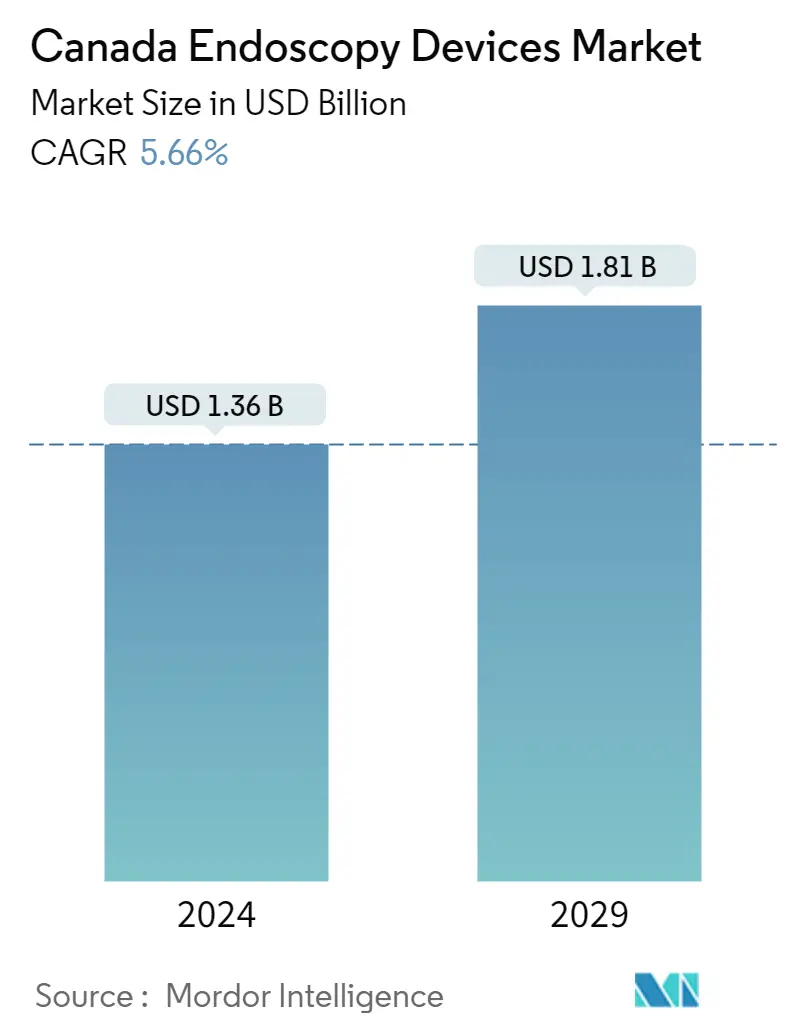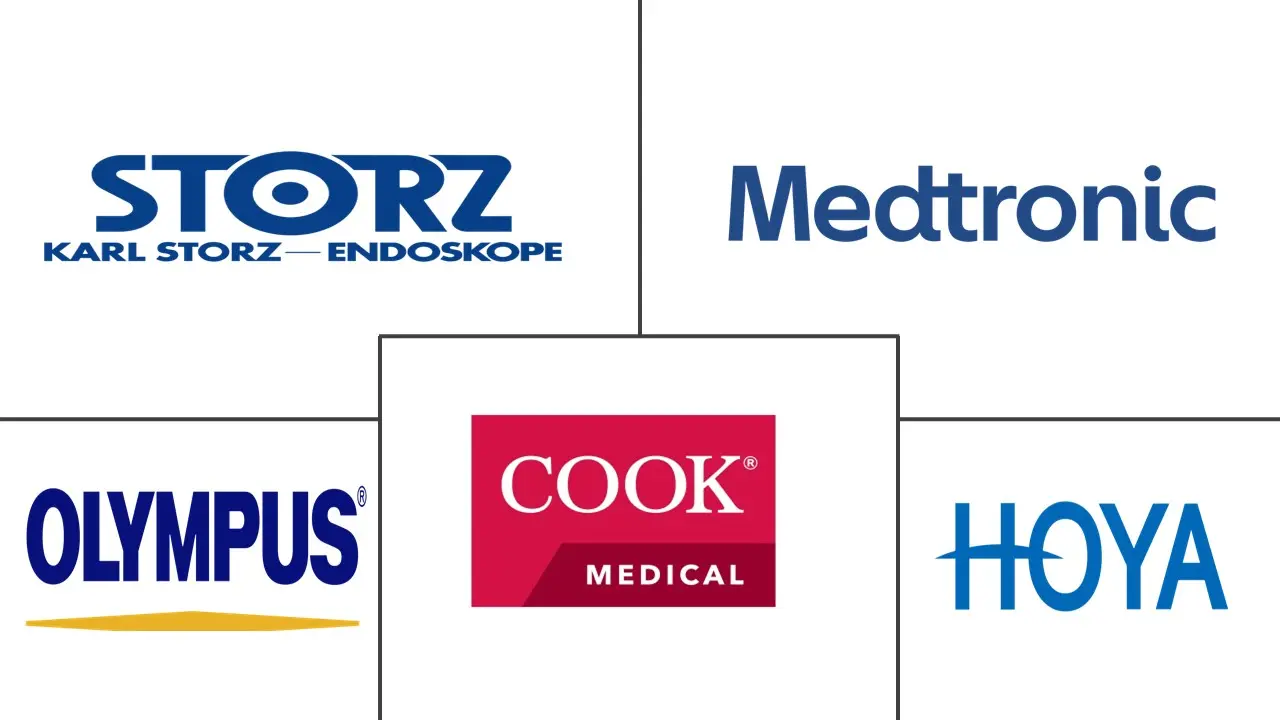Market Size of Canada Endoscopy Devices Industry

| Study Period | 2021 - 2029 |
| Base Year For Estimation | 2023 |
| Market Size (2024) | USD 1.36 Billion |
| Market Size (2029) | USD 1.81 Billion |
| CAGR (2024 - 2029) | 5.66 % |
| Market Concentration | High |
Major Players
*Disclaimer: Major Players sorted in no particular order |
Canada Endoscopy Devices Market Analysis
The Canada Endoscopy Devices Market size is estimated at USD 1.36 billion in 2024, and is expected to reach USD 1.81 billion by 2029, growing at a CAGR of 5.66% during the forecast period (2024-2029).
The COVID-19 pandemic had an impact on the growth of the market for endoscopic devices in Canada. According to the study published in the Journal of Gastroenterology and Hepatology in May 2022 stated that during the COVID-19 pandemic, there were modifications in the availability of endoscopic services. Patients hospitalized for upper gastrointestinal bleeding (UGIB) during the pandemic's initial wave were less likely to have an endoscopy. During the epidemic, endoscopic procedures revealed higher-than-expected rates of gastrointestinal bleeding and cancer. However, initiatives such as product launches are expected to increase market growth. For instance, in January 2021, PENTAX Medical increased the availability of the CapsoCam Plus video capsule system with Health Canada licensing in partnership with CapsoVision, Inc. This product expansion enables at-home administration of the CapsoCam Plus small bowel capsule endoscope during the COVID-19 pandemic for eligible patients, permitting a fully remote capsule endoscopy procedure and effectively eliminating the need for in-person interactions between clinicians and their patients. Thus, such expansions are expected to increase market growth.
Certain factors that are driving the market growth include a growing preference for minimally invasive surgeries and technological advancements. Minimally invasive surgeries (MIS) cause less post-operative pain, and hence, patients receive smaller dosages of painkillers. As there are minimal cuts or stitches involved, the hospital stay is relatively shorter, and patients need not visit the hospital frequently. Currently, people are showing interest in minimally invasive procedures rather than opting for traditional open surgeries that involve long incisions made through the muscles, and these muscles take a considerable amount of time to heal. Minimally invasive surgeries (MIS) involve smaller incisions, leading to quicker recovery. In addition, the body scars involved in minimally invasive surgeries (MIS) are barely noticeable. For instance, in June 2022, Olympus reported the first commercial treatment of Benign Prostatic Hyperplasia (BPH) in Canada utilizing the minimally invasive iTindTM method.
Additionally, the growing prevalence of chronic diseases is expected to boost the market over the forecast period. According to Globocan 2020, the incidence of stomach cancer in Canada was 3,505 in 2020, which is expected to reach 5,230 in 2040. This rising burden of cancer indicates the high requirement for endoscopic devices, which is expected to drive market study in the future.
Moreover, the rising product approval in the segment will also contribute to market growth. For instance, in April 2021, Ambu Inc. received Health Canada authorization for the aScope 4 Cysto, the company's unique flexible cystoscope platform for urology. Urologists across Canada have rapid access to a single-use cystoscope for detecting, controlling, and treating lower urinary illnesses such as hematuria, incontinence, and bladder cancer.
Thus, all aforementioned factors are expected to boost the market over the forecast period. However, infections caused by endoscopes may restrain the market growth.
Canada Endoscopy Devices Industry Segmentation
As per the scope of the report, endoscopy devices are minimally invasive and can be inserted into the natural openings of the body to observe an internal organ or a tissue in detail. Endoscopic surgeries are performed for imaging procedures and minor surgeries. An endoscope is a long, thin, flexible tube with a light source and camera at one end, and the inside images are relayed to a screen. The scope considers several aspects of the market studied in terms of devices and their applications. The Canada Endoscopy Devices Market is segmented by Type of Device (Endoscopes (Rigid Endoscope, Flexible Endoscope, Capsule Endoscope, Robot-assisted Endoscopes), Endoscopic Operative Devices, and Visualization Equipment) and Application. (Gastroenterology, Pulmonology, Orthopedic Surgery, Cardiology, ENT Surgery, Gynecology, Neurology, Urology). The report offers the value (in USD million) for the above segments.
| By Type of Device | ||||||
| ||||||
| Endoscopic Operative Device | ||||||
| Visualization Equipment |
| By Application | |
| Gastroenterology | |
| Pulmonology | |
| Orthopedic Surgery | |
| Cardiology | |
| ENT Surgery | |
| Gynecology | |
| Neurology | |
| Urology |
Canada Endoscopy Devices Market Size Summary
The Canada endoscopy market is poised for significant growth over the forecast period, driven by a combination of technological advancements and a rising preference for minimally invasive surgeries. The market is experiencing increased demand due to the growing prevalence of chronic diseases, such as gastrointestinal and colorectal cancers, which necessitate the use of endoscopic devices for early detection and treatment. The shift towards minimally invasive procedures is attributed to their benefits, including reduced postoperative pain, shorter hospital stays, and quicker recovery times. This trend is further supported by product innovations and regulatory approvals, such as the introduction of the CapsoCam Plus video capsule system and the iTindTM method for treating Benign Prostatic Hyperplasia, which enhance the availability and efficacy of endoscopic procedures.
The market landscape is characterized by a mix of global and local players, with major companies like Karl Storz, Medtronic PLC, Hoya Corporation, Cook Medical, and Olympus Corporation leading the charge. These companies are actively expanding their product offerings and securing regulatory approvals to strengthen their market positions. For instance, the launch of the Performance Endoscopic Ultrasound system by PENTAX Medical and the Health Canada license for Medtronic's Hugo robotic-assisted surgery system highlight the ongoing innovation in the sector. Despite the challenges posed by potential infections from endoscopic procedures, the overall market outlook remains positive, driven by the increasing incidence of neurological disorders and the growing demand for neuroendoscopy.
Canada Endoscopy Devices Market Size - Table of Contents
-
1. MARKET DYNAMICS
-
1.1 Market Overview
-
1.2 Market Drivers
-
1.2.1 Growing Preference for Minimally Invasive Surgeries
-
1.2.2 Technological Advancements Leading to Enhanced Applications
-
-
1.3 Market Restraints
-
1.3.1 Infections Caused by Few Endoscopes
-
-
1.4 Porter Five Forces
-
1.4.1 Threat of New Entrants
-
1.4.2 Bargaining Power of Buyers/Consumers
-
1.4.3 Bargaining Power of Suppliers
-
1.4.4 Threat of Substitute Products
-
1.4.5 Intensity of Competitive Rivalry
-
-
-
2. MARKET SEGMENTATION (Market Size by Value - in USD Million)
-
2.1 By Type of Device
-
2.1.1 Endoscopes
-
2.1.1.1 Rigid Endoscope
-
2.1.1.2 Flexible Endoscope
-
2.1.1.3 Capsule Endoscope
-
2.1.1.4 Robot-assisted Endoscope
-
-
2.1.2 Endoscopic Operative Device
-
2.1.3 Visualization Equipment
-
-
2.2 By Application
-
2.2.1 Gastroenterology
-
2.2.2 Pulmonology
-
2.2.3 Orthopedic Surgery
-
2.2.4 Cardiology
-
2.2.5 ENT Surgery
-
2.2.6 Gynecology
-
2.2.7 Neurology
-
2.2.8 Urology
-
-
Canada Endoscopy Devices Market Size FAQs
How big is the Canada Endoscopy Devices Market?
The Canada Endoscopy Devices Market size is expected to reach USD 1.36 billion in 2024 and grow at a CAGR of 5.66% to reach USD 1.81 billion by 2029.
What is the current Canada Endoscopy Devices Market size?
In 2024, the Canada Endoscopy Devices Market size is expected to reach USD 1.36 billion.

